Master of Engineering Thesis: SICK AG Business Process Development
VerifiedAdded on 2020/03/02
|81
|20726
|40
Thesis and Dissertation
AI Summary
This minor thesis, submitted by a student at the University of South Australia, addresses the development of new business processes for SICK AG, a manufacturing company transitioning from a simple equipment supplier to an integrated system solution provider. The thesis analyzes the company's current system, identifies challenges in adapting to the Australian market, and explores alternative solutions, including Business Process Reengineering (BPR) and modified Customer Project Management (CPM). It focuses on improving customer satisfaction and reducing rework costs. The research includes a literature review, problem analysis, development of solutions, solution implementation, testing, evaluation, and cost-benefit analysis, culminating in recommendations for future work. The study emphasizes the importance of local adaptation, integration, and effective project management to enhance the company's business model in the Australian context. The thesis provides a comprehensive overview of the issues faced and the proposed solutions for SICK AG's business transformation.
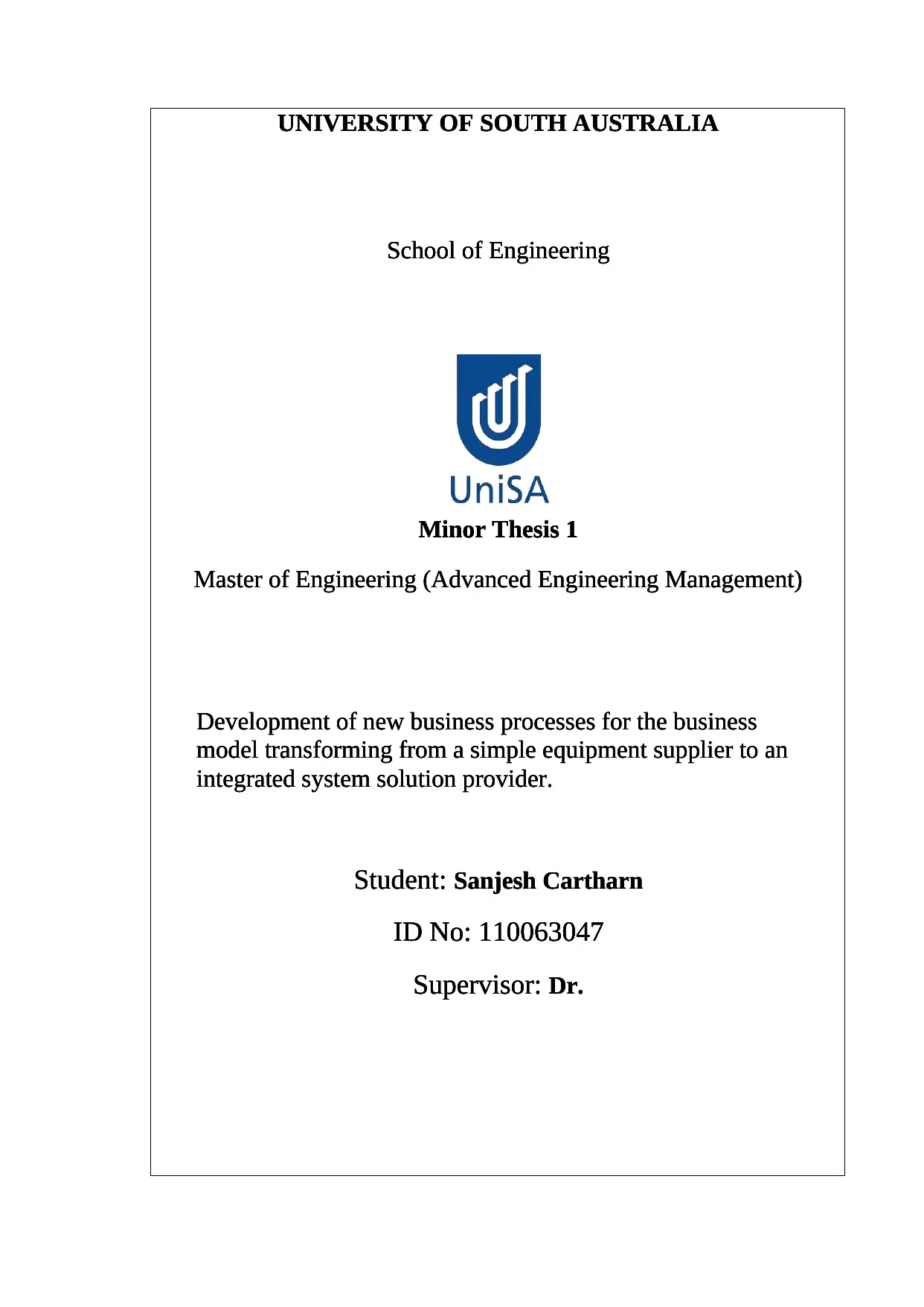
UNIVERSITY OF SOUTH AUSTRALIA
School of Engineering
Minor Thesis 1
Master of Engineering (Advanced Engineering Management)
Development of new business processes for the business
model transforming from a simple equipment supplier to an
integrated system solution provider.
Student: Sanjesh Cartharn
ID No: 110063047
Supervisor: Dr.
UNIVERSITY OF SOUTH AUSTRALIA
School of Engineering
Minor Thesis 1
Master of Engineering (Advanced Engineering Management)
Development of new business processes for the business
model transforming from a simple equipment supplier to an
integrated system solution provider.
Student: Sanjesh Cartharn
ID No: 110063047
Supervisor: Dr.
UNIVERSITY OF SOUTH AUSTRALIA
School of Engineering
Minor Thesis 1
Master of Engineering (Advanced Engineering Management)
Development of new business processes for the business
model transforming from a simple equipment supplier to an
integrated system solution provider.
Student: Sanjesh Cartharn
ID No: 110063047
Supervisor: Dr.
UNIVERSITY OF SOUTH AUSTRALIA
School of Engineering
Minor Thesis 1
Master of Engineering (Advanced Engineering Management)
Development of new business processes for the business
model transforming from a simple equipment supplier to an
integrated system solution provider.
Student: Sanjesh Cartharn
ID No: 110063047
Supervisor: Dr.
School of Engineering
Minor Thesis 1
Master of Engineering (Advanced Engineering Management)
Development of new business processes for the business
model transforming from a simple equipment supplier to an
integrated system solution provider.
Student: Sanjesh Cartharn
ID No: 110063047
Supervisor: Dr.
UNIVERSITY OF SOUTH AUSTRALIA
School of Engineering
Minor Thesis 1
Master of Engineering (Advanced Engineering Management)
Development of new business processes for the business
model transforming from a simple equipment supplier to an
integrated system solution provider.
Student: Sanjesh Cartharn
ID No: 110063047
Supervisor: Dr.
UNIVERSITY OF SOUTH AUSTRALIA
School of Engineering
Minor Thesis 1
Master of Engineering (Advanced Engineering Management)
Development of new business processes for the business
model transforming from a simple equipment supplier to an
integrated system solution provider.
Student: Sanjesh Cartharn
ID No: 110063047
Supervisor: Dr.
UNIVERSITY OF SOUTH AUSTRALIA
School of Engineering
Minor Thesis 1
Master of Engineering (Advanced Engineering Management)
Development of new business processes for the business
model transforming from a simple equipment supplier to an
integrated system solution provider.
Student: Sanjesh Cartharn
ID No: 110063047
Supervisor: Dr.
Paraphrase This Document
Need a fresh take? Get an instant paraphrase of this document with our AI Paraphraser
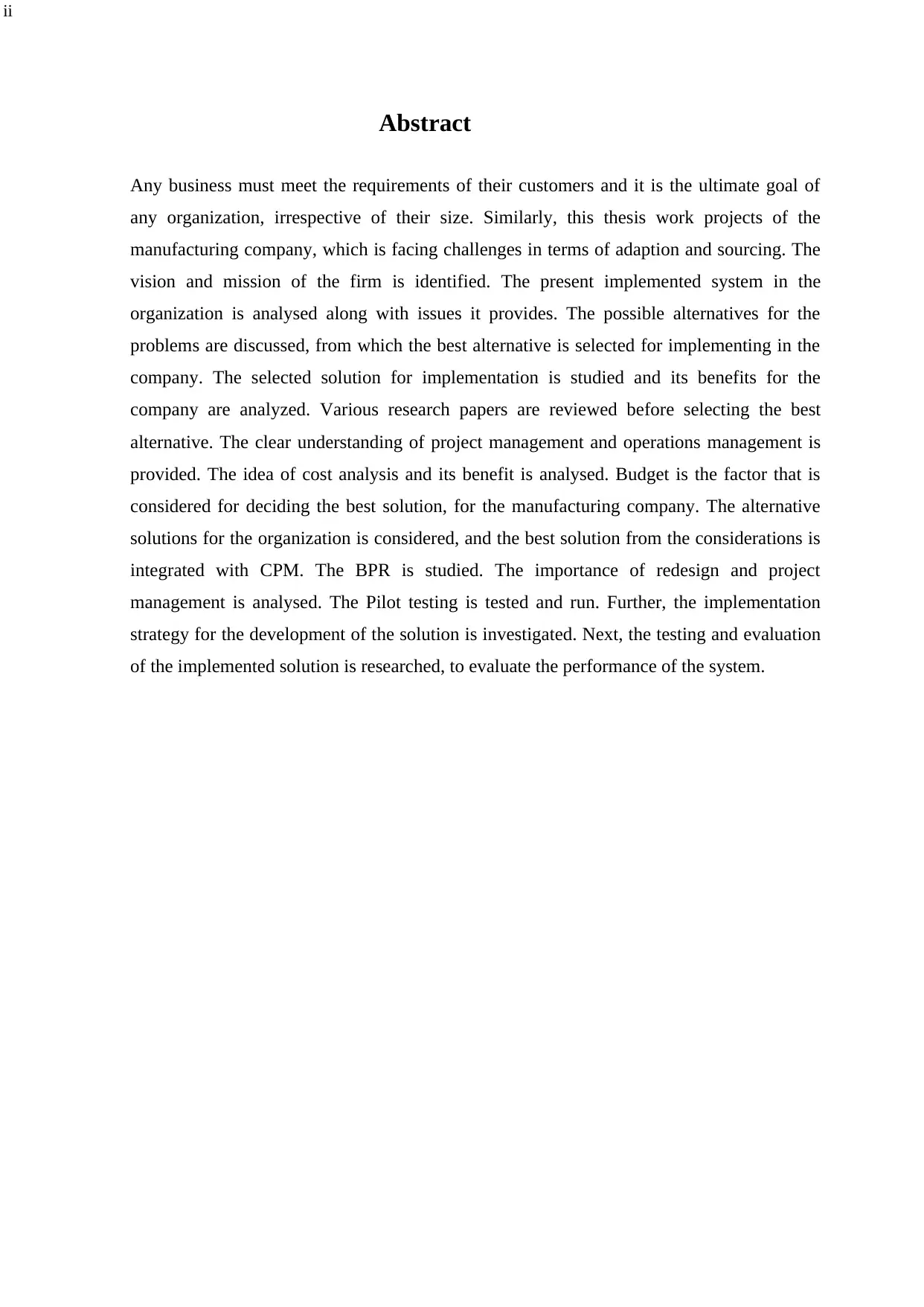
ii
Abstract
Any business must meet the requirements of their customers and it is the ultimate goal of
any organization, irrespective of their size. Similarly, this thesis work projects of the
manufacturing company, which is facing challenges in terms of adaption and sourcing. The
vision and mission of the firm is identified. The present implemented system in the
organization is analysed along with issues it provides. The possible alternatives for the
problems are discussed, from which the best alternative is selected for implementing in the
company. The selected solution for implementation is studied and its benefits for the
company are analyzed. Various research papers are reviewed before selecting the best
alternative. The clear understanding of project management and operations management is
provided. The idea of cost analysis and its benefit is analysed. Budget is the factor that is
considered for deciding the best solution, for the manufacturing company. The alternative
solutions for the organization is considered, and the best solution from the considerations is
integrated with CPM. The BPR is studied. The importance of redesign and project
management is analysed. The Pilot testing is tested and run. Further, the implementation
strategy for the development of the solution is investigated. Next, the testing and evaluation
of the implemented solution is researched, to evaluate the performance of the system.
Abstract
Any business must meet the requirements of their customers and it is the ultimate goal of
any organization, irrespective of their size. Similarly, this thesis work projects of the
manufacturing company, which is facing challenges in terms of adaption and sourcing. The
vision and mission of the firm is identified. The present implemented system in the
organization is analysed along with issues it provides. The possible alternatives for the
problems are discussed, from which the best alternative is selected for implementing in the
company. The selected solution for implementation is studied and its benefits for the
company are analyzed. Various research papers are reviewed before selecting the best
alternative. The clear understanding of project management and operations management is
provided. The idea of cost analysis and its benefit is analysed. Budget is the factor that is
considered for deciding the best solution, for the manufacturing company. The alternative
solutions for the organization is considered, and the best solution from the considerations is
integrated with CPM. The BPR is studied. The importance of redesign and project
management is analysed. The Pilot testing is tested and run. Further, the implementation
strategy for the development of the solution is investigated. Next, the testing and evaluation
of the implemented solution is researched, to evaluate the performance of the system.
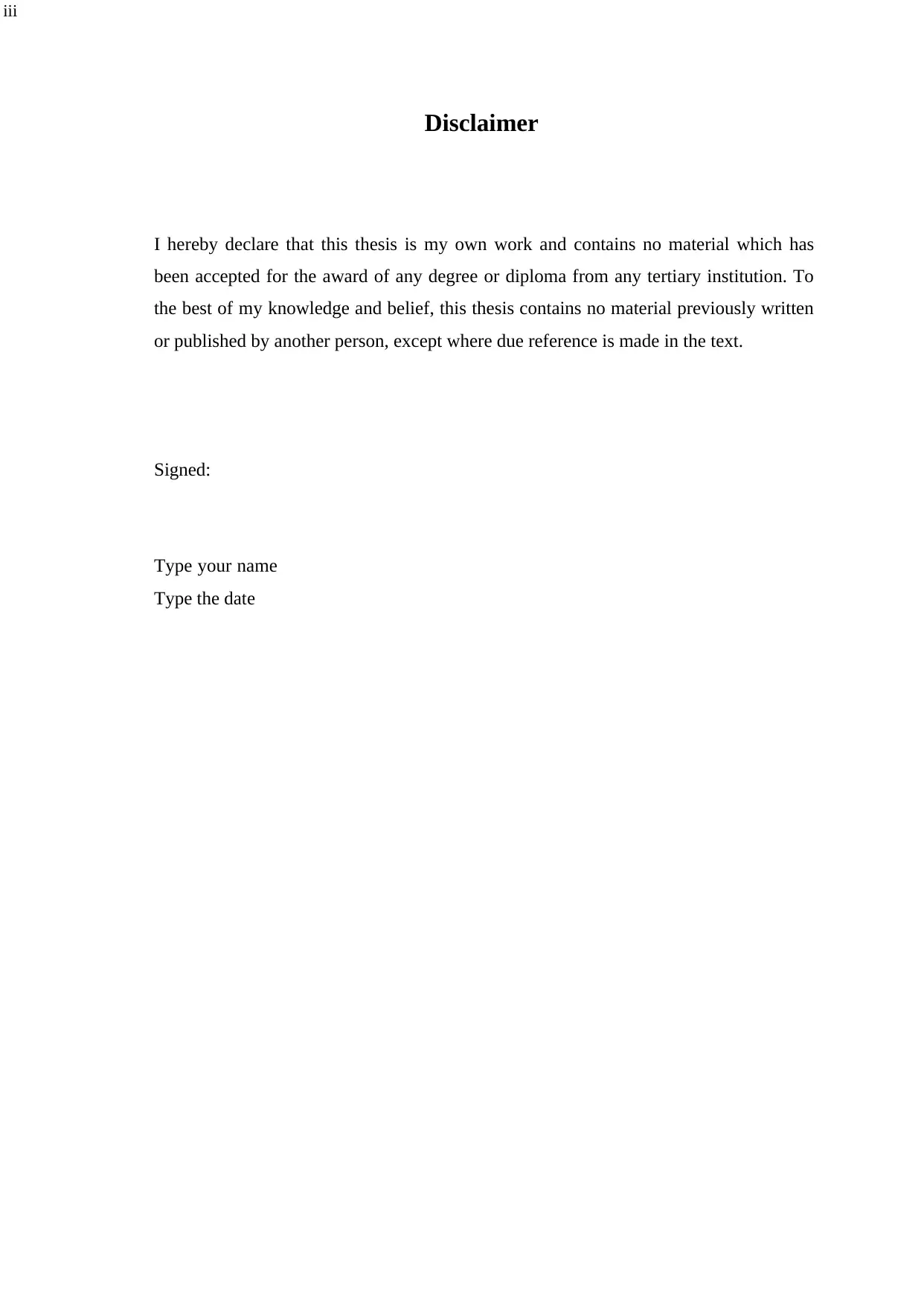
iii
Disclaimer
I hereby declare that this thesis is my own work and contains no material which has
been accepted for the award of any degree or diploma from any tertiary institution. To
the best of my knowledge and belief, this thesis contains no material previously written
or published by another person, except where due reference is made in the text.
Signed:
Type your name
Type the date
Disclaimer
I hereby declare that this thesis is my own work and contains no material which has
been accepted for the award of any degree or diploma from any tertiary institution. To
the best of my knowledge and belief, this thesis contains no material previously written
or published by another person, except where due reference is made in the text.
Signed:
Type your name
Type the date
⊘ This is a preview!⊘
Do you want full access?
Subscribe today to unlock all pages.

Trusted by 1+ million students worldwide
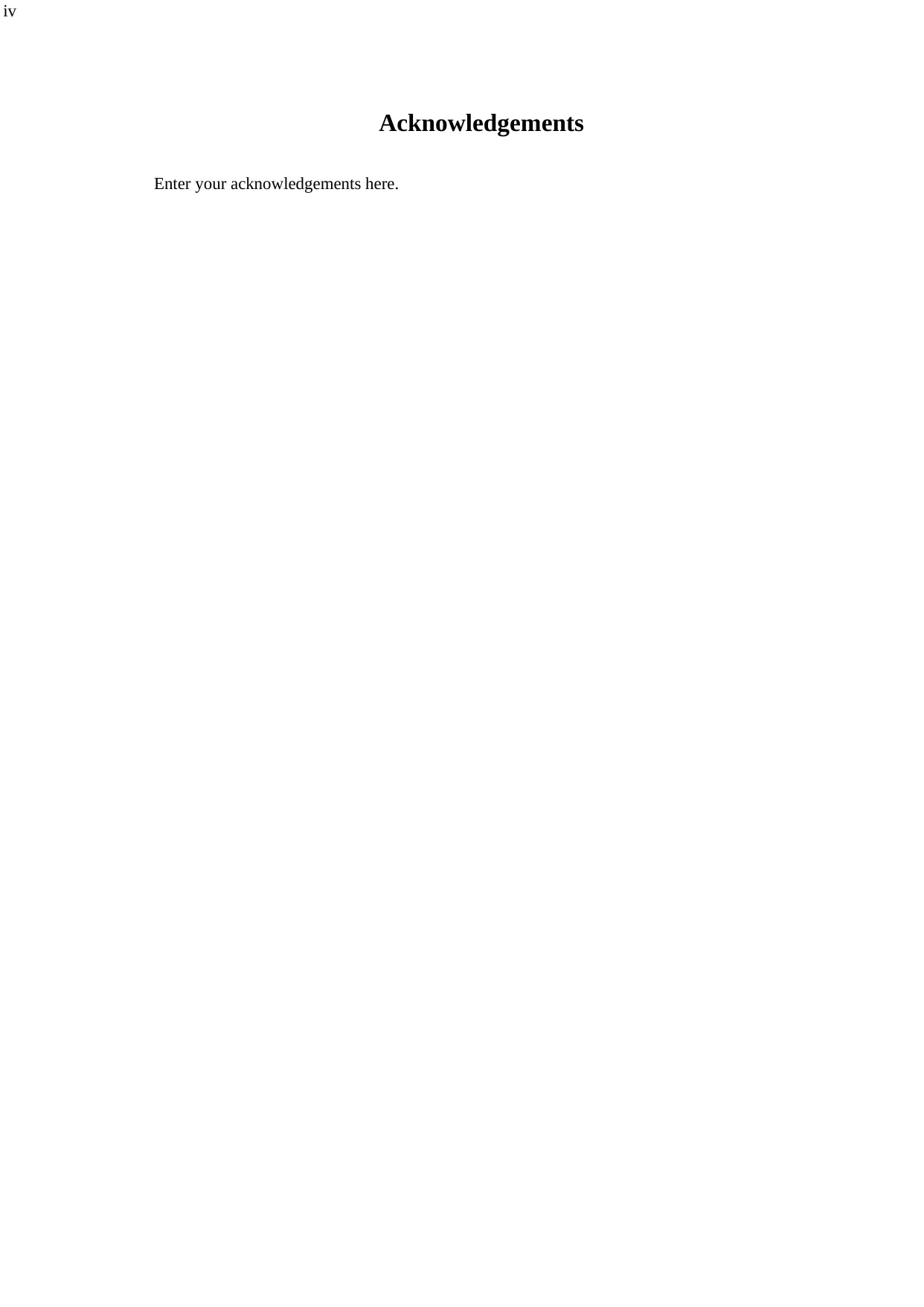
iv
Acknowledgements
Enter your acknowledgements here.
Acknowledgements
Enter your acknowledgements here.
Paraphrase This Document
Need a fresh take? Get an instant paraphrase of this document with our AI Paraphraser
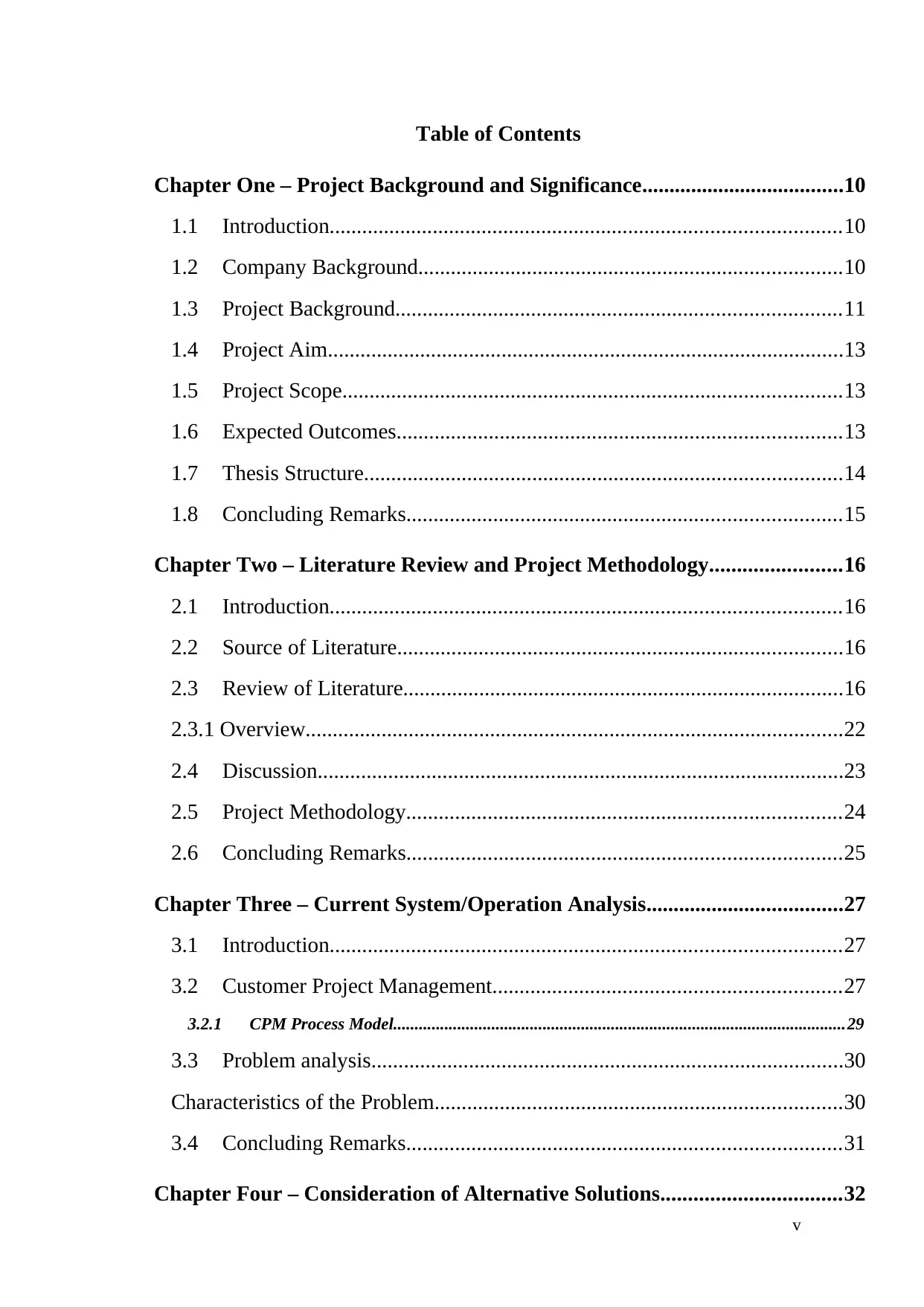
v
Table of Contents
Chapter One – Project Background and Significance.....................................10
1.1 Introduction..............................................................................................10
1.2 Company Background..............................................................................10
1.3 Project Background..................................................................................11
1.4 Project Aim...............................................................................................13
1.5 Project Scope............................................................................................13
1.6 Expected Outcomes..................................................................................13
1.7 Thesis Structure........................................................................................14
1.8 Concluding Remarks................................................................................15
Chapter Two – Literature Review and Project Methodology........................16
2.1 Introduction..............................................................................................16
2.2 Source of Literature..................................................................................16
2.3 Review of Literature.................................................................................16
2.3.1 Overview...................................................................................................22
2.4 Discussion.................................................................................................23
2.5 Project Methodology................................................................................24
2.6 Concluding Remarks................................................................................25
Chapter Three – Current System/Operation Analysis....................................27
3.1 Introduction..............................................................................................27
3.2 Customer Project Management................................................................27
3.2.1 CPM Process Model..........................................................................................................29
3.3 Problem analysis.......................................................................................30
Characteristics of the Problem...........................................................................30
3.4 Concluding Remarks................................................................................31
Chapter Four – Consideration of Alternative Solutions.................................32
Table of Contents
Chapter One – Project Background and Significance.....................................10
1.1 Introduction..............................................................................................10
1.2 Company Background..............................................................................10
1.3 Project Background..................................................................................11
1.4 Project Aim...............................................................................................13
1.5 Project Scope............................................................................................13
1.6 Expected Outcomes..................................................................................13
1.7 Thesis Structure........................................................................................14
1.8 Concluding Remarks................................................................................15
Chapter Two – Literature Review and Project Methodology........................16
2.1 Introduction..............................................................................................16
2.2 Source of Literature..................................................................................16
2.3 Review of Literature.................................................................................16
2.3.1 Overview...................................................................................................22
2.4 Discussion.................................................................................................23
2.5 Project Methodology................................................................................24
2.6 Concluding Remarks................................................................................25
Chapter Three – Current System/Operation Analysis....................................27
3.1 Introduction..............................................................................................27
3.2 Customer Project Management................................................................27
3.2.1 CPM Process Model..........................................................................................................29
3.3 Problem analysis.......................................................................................30
Characteristics of the Problem...........................................................................30
3.4 Concluding Remarks................................................................................31
Chapter Four – Consideration of Alternative Solutions.................................32
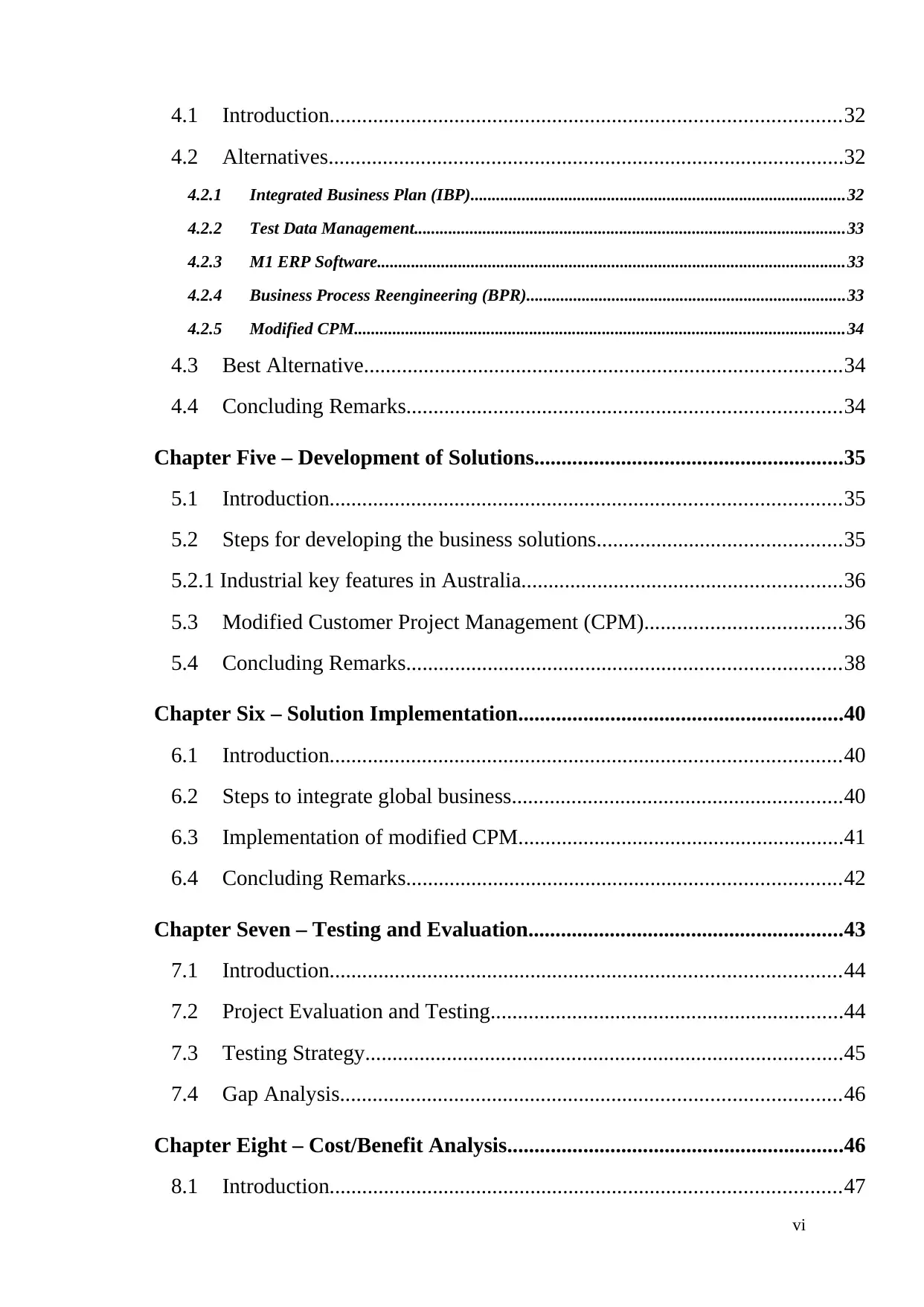
vi
4.1 Introduction..............................................................................................32
4.2 Alternatives...............................................................................................32
4.2.1 Integrated Business Plan (IBP)........................................................................................32
4.2.2 Test Data Management.....................................................................................................33
4.2.3 M1 ERP Software..............................................................................................................33
4.2.4 Business Process Reengineering (BPR)...........................................................................33
4.2.5 Modified CPM...................................................................................................................34
4.3 Best Alternative........................................................................................34
4.4 Concluding Remarks................................................................................34
Chapter Five – Development of Solutions.........................................................35
5.1 Introduction..............................................................................................35
5.2 Steps for developing the business solutions.............................................35
5.2.1 Industrial key features in Australia...........................................................36
5.3 Modified Customer Project Management (CPM)....................................36
5.4 Concluding Remarks................................................................................38
Chapter Six – Solution Implementation............................................................40
6.1 Introduction..............................................................................................40
6.2 Steps to integrate global business.............................................................40
6.3 Implementation of modified CPM............................................................41
6.4 Concluding Remarks................................................................................42
Chapter Seven – Testing and Evaluation..........................................................43
7.1 Introduction..............................................................................................44
7.2 Project Evaluation and Testing.................................................................44
7.3 Testing Strategy........................................................................................45
7.4 Gap Analysis............................................................................................46
Chapter Eight – Cost/Benefit Analysis..............................................................46
8.1 Introduction..............................................................................................47
4.1 Introduction..............................................................................................32
4.2 Alternatives...............................................................................................32
4.2.1 Integrated Business Plan (IBP)........................................................................................32
4.2.2 Test Data Management.....................................................................................................33
4.2.3 M1 ERP Software..............................................................................................................33
4.2.4 Business Process Reengineering (BPR)...........................................................................33
4.2.5 Modified CPM...................................................................................................................34
4.3 Best Alternative........................................................................................34
4.4 Concluding Remarks................................................................................34
Chapter Five – Development of Solutions.........................................................35
5.1 Introduction..............................................................................................35
5.2 Steps for developing the business solutions.............................................35
5.2.1 Industrial key features in Australia...........................................................36
5.3 Modified Customer Project Management (CPM)....................................36
5.4 Concluding Remarks................................................................................38
Chapter Six – Solution Implementation............................................................40
6.1 Introduction..............................................................................................40
6.2 Steps to integrate global business.............................................................40
6.3 Implementation of modified CPM............................................................41
6.4 Concluding Remarks................................................................................42
Chapter Seven – Testing and Evaluation..........................................................43
7.1 Introduction..............................................................................................44
7.2 Project Evaluation and Testing.................................................................44
7.3 Testing Strategy........................................................................................45
7.4 Gap Analysis............................................................................................46
Chapter Eight – Cost/Benefit Analysis..............................................................46
8.1 Introduction..............................................................................................47
⊘ This is a preview!⊘
Do you want full access?
Subscribe today to unlock all pages.

Trusted by 1+ million students worldwide
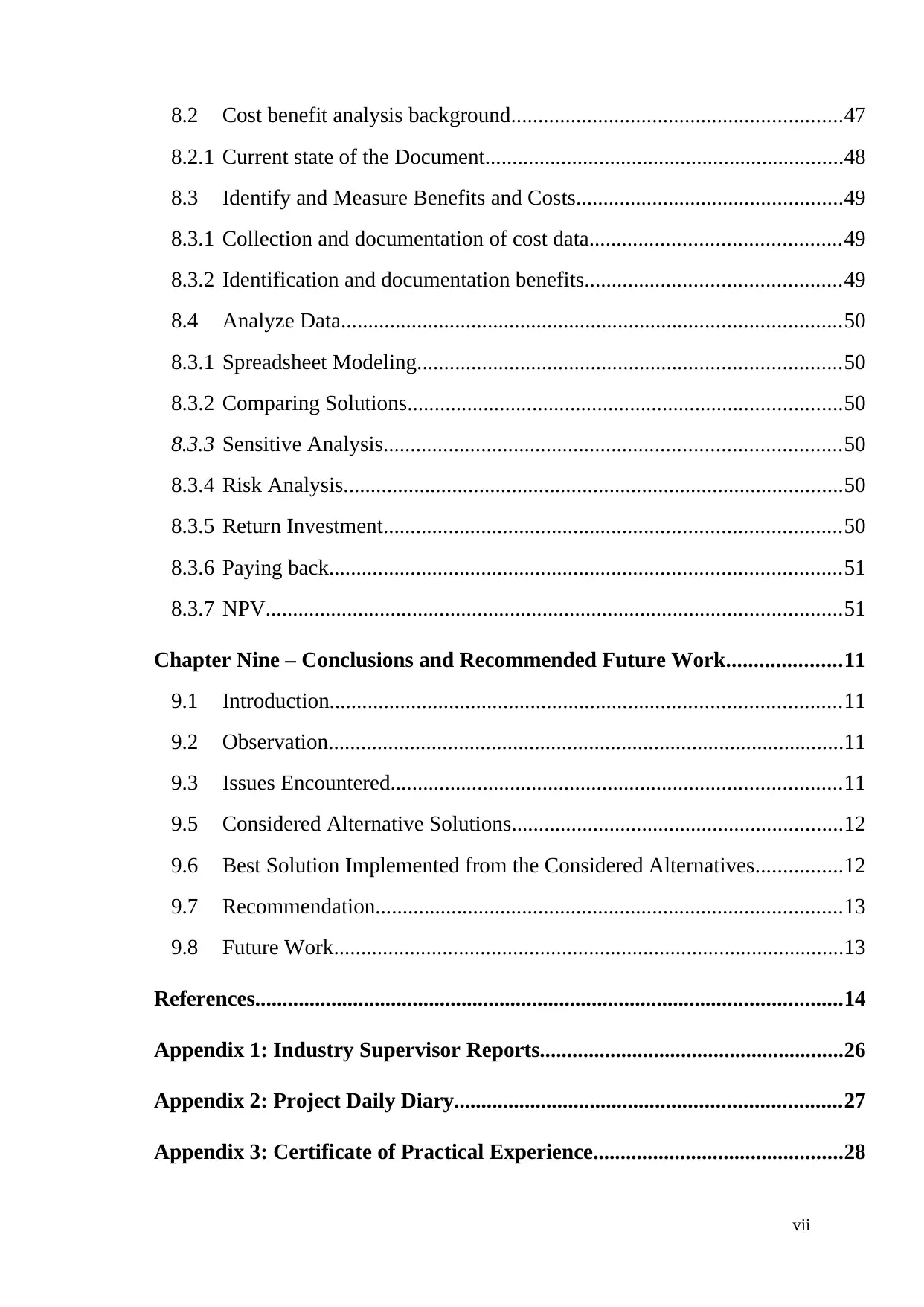
vii
8.2 Cost benefit analysis background.............................................................47
8.2.1 Current state of the Document..................................................................48
8.3 Identify and Measure Benefits and Costs.................................................49
8.3.1 Collection and documentation of cost data..............................................49
8.3.2 Identification and documentation benefits...............................................49
8.4 Analyze Data............................................................................................50
8.3.1 Spreadsheet Modeling..............................................................................50
8.3.2 Comparing Solutions................................................................................50
8.3.3 Sensitive Analysis....................................................................................50
8.3.4 Risk Analysis............................................................................................50
8.3.5 Return Investment....................................................................................50
8.3.6 Paying back..............................................................................................51
8.3.7 NPV..........................................................................................................51
Chapter Nine – Conclusions and Recommended Future Work.....................11
9.1 Introduction..............................................................................................11
9.2 Observation...............................................................................................11
9.3 Issues Encountered...................................................................................11
9.5 Considered Alternative Solutions.............................................................12
9.6 Best Solution Implemented from the Considered Alternatives................12
9.7 Recommendation......................................................................................13
9.8 Future Work..............................................................................................13
References............................................................................................................14
Appendix 1: Industry Supervisor Reports........................................................26
Appendix 2: Project Daily Diary.......................................................................27
Appendix 3: Certificate of Practical Experience..............................................28
8.2 Cost benefit analysis background.............................................................47
8.2.1 Current state of the Document..................................................................48
8.3 Identify and Measure Benefits and Costs.................................................49
8.3.1 Collection and documentation of cost data..............................................49
8.3.2 Identification and documentation benefits...............................................49
8.4 Analyze Data............................................................................................50
8.3.1 Spreadsheet Modeling..............................................................................50
8.3.2 Comparing Solutions................................................................................50
8.3.3 Sensitive Analysis....................................................................................50
8.3.4 Risk Analysis............................................................................................50
8.3.5 Return Investment....................................................................................50
8.3.6 Paying back..............................................................................................51
8.3.7 NPV..........................................................................................................51
Chapter Nine – Conclusions and Recommended Future Work.....................11
9.1 Introduction..............................................................................................11
9.2 Observation...............................................................................................11
9.3 Issues Encountered...................................................................................11
9.5 Considered Alternative Solutions.............................................................12
9.6 Best Solution Implemented from the Considered Alternatives................12
9.7 Recommendation......................................................................................13
9.8 Future Work..............................................................................................13
References............................................................................................................14
Appendix 1: Industry Supervisor Reports........................................................26
Appendix 2: Project Daily Diary.......................................................................27
Appendix 3: Certificate of Practical Experience..............................................28
Paraphrase This Document
Need a fresh take? Get an instant paraphrase of this document with our AI Paraphraser

viii
List of Tables
Table 1.1 Insert table title...........................................................................................................2
List of Tables
Table 1.1 Insert table title...........................................................................................................2
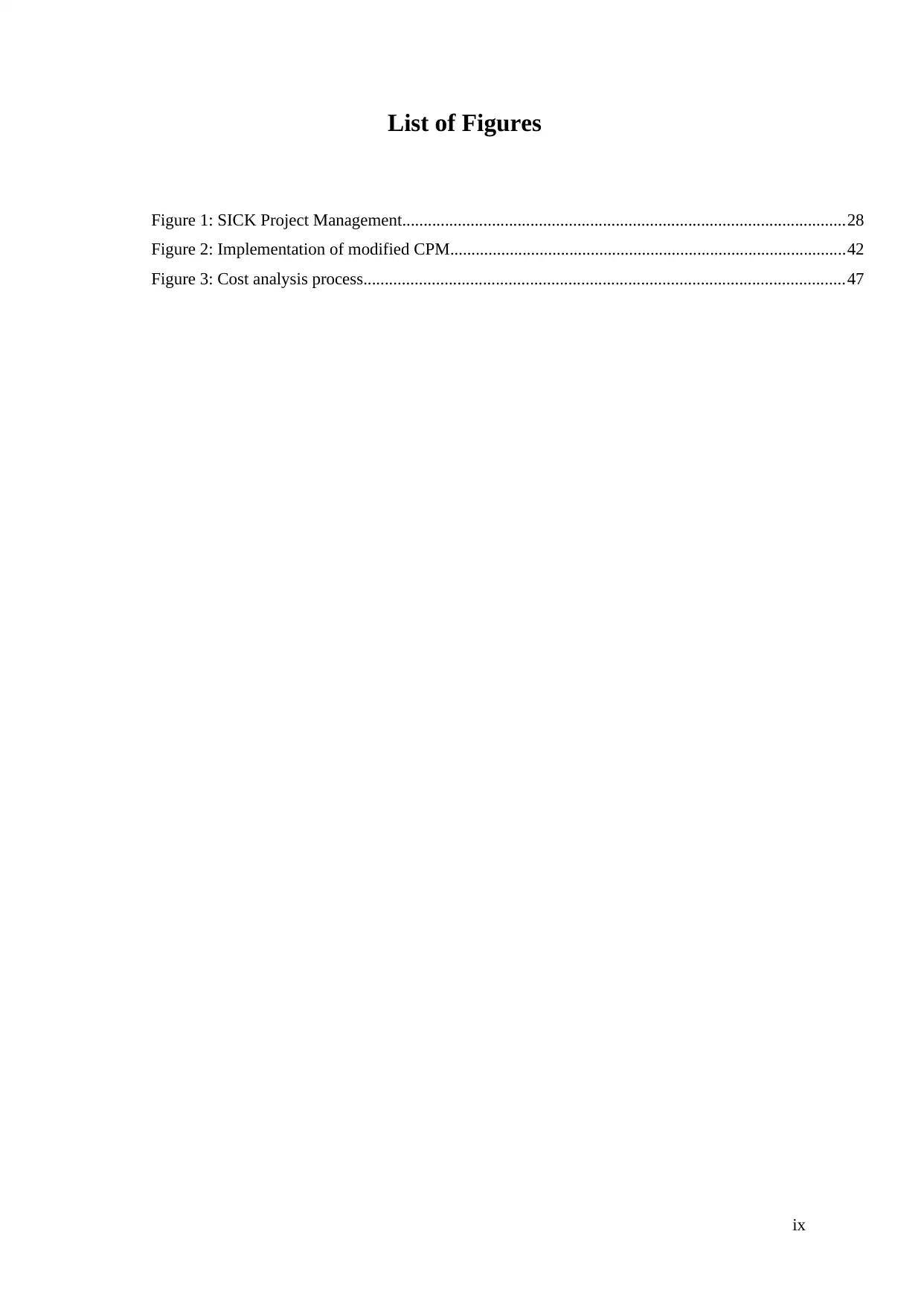
ix
List of Figures
Figure 1: SICK Project Management........................................................................................................28
Figure 2: Implementation of modified CPM.............................................................................................42
Figure 3: Cost analysis process.................................................................................................................47
List of Figures
Figure 1: SICK Project Management........................................................................................................28
Figure 2: Implementation of modified CPM.............................................................................................42
Figure 3: Cost analysis process.................................................................................................................47
⊘ This is a preview!⊘
Do you want full access?
Subscribe today to unlock all pages.

Trusted by 1+ million students worldwide
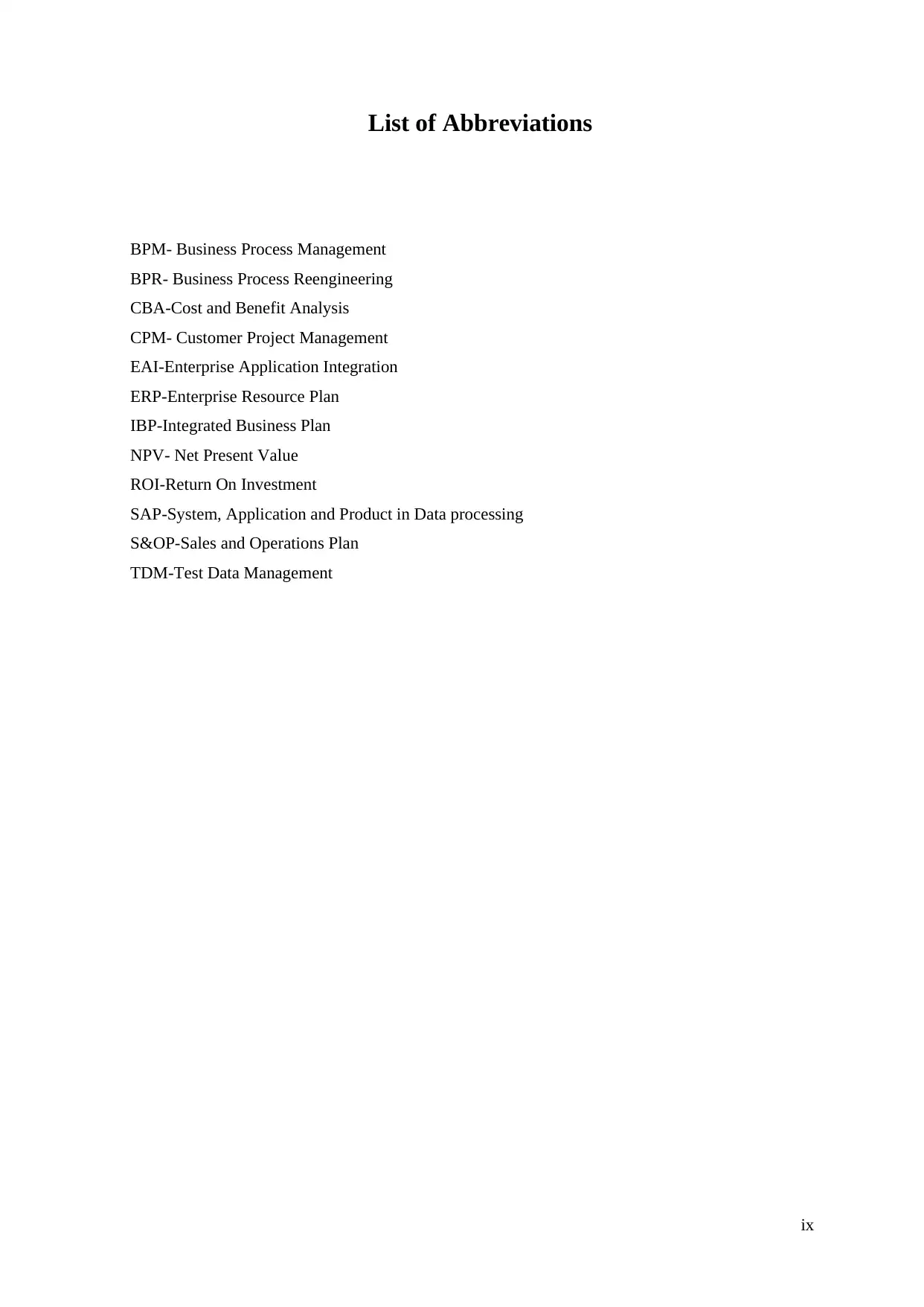
ix
List of Abbreviations
BPM- Business Process Management
BPR- Business Process Reengineering
CBA-Cost and Benefit Analysis
CPM- Customer Project Management
EAI-Enterprise Application Integration
ERP-Enterprise Resource Plan
IBP-Integrated Business Plan
NPV- Net Present Value
ROI-Return On Investment
SAP-System, Application and Product in Data processing
S&OP-Sales and Operations Plan
TDM-Test Data Management
List of Abbreviations
BPM- Business Process Management
BPR- Business Process Reengineering
CBA-Cost and Benefit Analysis
CPM- Customer Project Management
EAI-Enterprise Application Integration
ERP-Enterprise Resource Plan
IBP-Integrated Business Plan
NPV- Net Present Value
ROI-Return On Investment
SAP-System, Application and Product in Data processing
S&OP-Sales and Operations Plan
TDM-Test Data Management
Paraphrase This Document
Need a fresh take? Get an instant paraphrase of this document with our AI Paraphraser
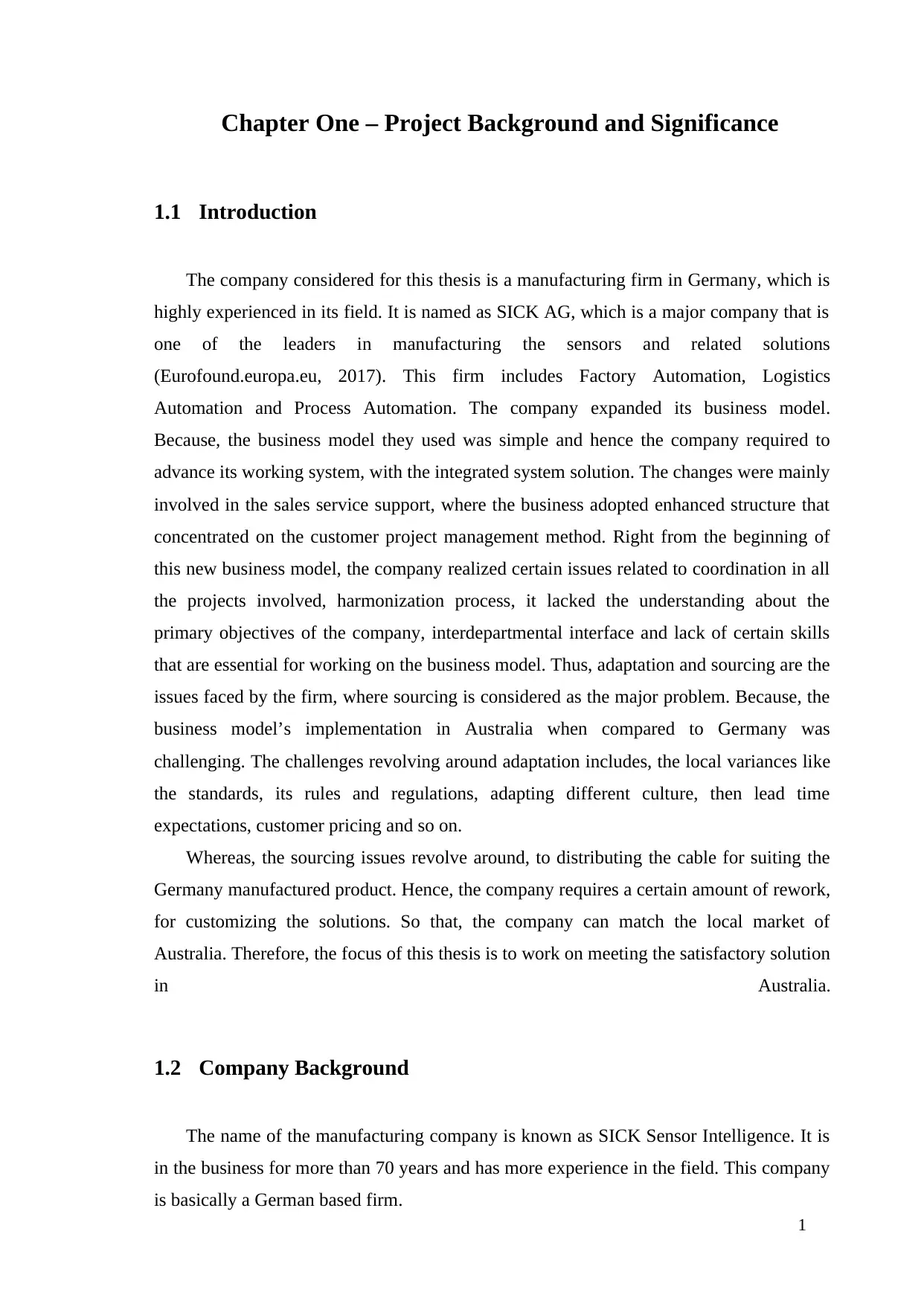
1
Chapter One – Project Background and Significance
1.1 Introduction
The company considered for this thesis is a manufacturing firm in Germany, which is
highly experienced in its field. It is named as SICK AG, which is a major company that is
one of the leaders in manufacturing the sensors and related solutions
(Eurofound.europa.eu, 2017). This firm includes Factory Automation, Logistics
Automation and Process Automation. The company expanded its business model.
Because, the business model they used was simple and hence the company required to
advance its working system, with the integrated system solution. The changes were mainly
involved in the sales service support, where the business adopted enhanced structure that
concentrated on the customer project management method. Right from the beginning of
this new business model, the company realized certain issues related to coordination in all
the projects involved, harmonization process, it lacked the understanding about the
primary objectives of the company, interdepartmental interface and lack of certain skills
that are essential for working on the business model. Thus, adaptation and sourcing are the
issues faced by the firm, where sourcing is considered as the major problem. Because, the
business model’s implementation in Australia when compared to Germany was
challenging. The challenges revolving around adaptation includes, the local variances like
the standards, its rules and regulations, adapting different culture, then lead time
expectations, customer pricing and so on.
Whereas, the sourcing issues revolve around, to distributing the cable for suiting the
Germany manufactured product. Hence, the company requires a certain amount of rework,
for customizing the solutions. So that, the company can match the local market of
Australia. Therefore, the focus of this thesis is to work on meeting the satisfactory solution
in Australia.
1.2 Company Background
The name of the manufacturing company is known as SICK Sensor Intelligence. It is
in the business for more than 70 years and has more experience in the field. This company
is basically a German based firm.
Chapter One – Project Background and Significance
1.1 Introduction
The company considered for this thesis is a manufacturing firm in Germany, which is
highly experienced in its field. It is named as SICK AG, which is a major company that is
one of the leaders in manufacturing the sensors and related solutions
(Eurofound.europa.eu, 2017). This firm includes Factory Automation, Logistics
Automation and Process Automation. The company expanded its business model.
Because, the business model they used was simple and hence the company required to
advance its working system, with the integrated system solution. The changes were mainly
involved in the sales service support, where the business adopted enhanced structure that
concentrated on the customer project management method. Right from the beginning of
this new business model, the company realized certain issues related to coordination in all
the projects involved, harmonization process, it lacked the understanding about the
primary objectives of the company, interdepartmental interface and lack of certain skills
that are essential for working on the business model. Thus, adaptation and sourcing are the
issues faced by the firm, where sourcing is considered as the major problem. Because, the
business model’s implementation in Australia when compared to Germany was
challenging. The challenges revolving around adaptation includes, the local variances like
the standards, its rules and regulations, adapting different culture, then lead time
expectations, customer pricing and so on.
Whereas, the sourcing issues revolve around, to distributing the cable for suiting the
Germany manufactured product. Hence, the company requires a certain amount of rework,
for customizing the solutions. So that, the company can match the local market of
Australia. Therefore, the focus of this thesis is to work on meeting the satisfactory solution
in Australia.
1.2 Company Background
The name of the manufacturing company is known as SICK Sensor Intelligence. It is
in the business for more than 70 years and has more experience in the field. This company
is basically a German based firm.
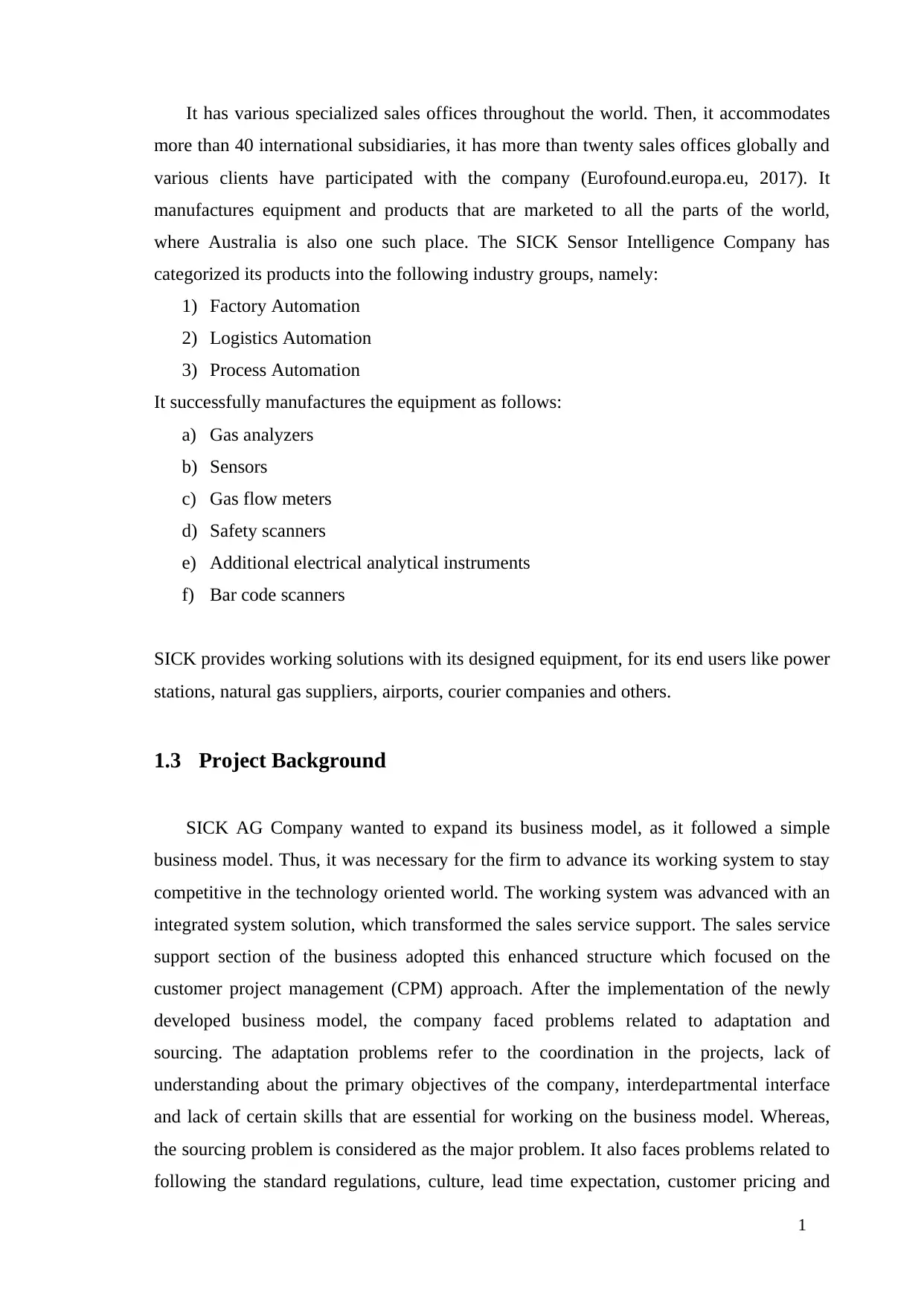
1
It has various specialized sales offices throughout the world. Then, it accommodates
more than 40 international subsidiaries, it has more than twenty sales offices globally and
various clients have participated with the company (Eurofound.europa.eu, 2017). It
manufactures equipment and products that are marketed to all the parts of the world,
where Australia is also one such place. The SICK Sensor Intelligence Company has
categorized its products into the following industry groups, namely:
1) Factory Automation
2) Logistics Automation
3) Process Automation
It successfully manufactures the equipment as follows:
a) Gas analyzers
b) Sensors
c) Gas flow meters
d) Safety scanners
e) Additional electrical analytical instruments
f) Bar code scanners
SICK provides working solutions with its designed equipment, for its end users like power
stations, natural gas suppliers, airports, courier companies and others.
1.3 Project Background
SICK AG Company wanted to expand its business model, as it followed a simple
business model. Thus, it was necessary for the firm to advance its working system to stay
competitive in the technology oriented world. The working system was advanced with an
integrated system solution, which transformed the sales service support. The sales service
support section of the business adopted this enhanced structure which focused on the
customer project management (CPM) approach. After the implementation of the newly
developed business model, the company faced problems related to adaptation and
sourcing. The adaptation problems refer to the coordination in the projects, lack of
understanding about the primary objectives of the company, interdepartmental interface
and lack of certain skills that are essential for working on the business model. Whereas,
the sourcing problem is considered as the major problem. It also faces problems related to
following the standard regulations, culture, lead time expectation, customer pricing and
It has various specialized sales offices throughout the world. Then, it accommodates
more than 40 international subsidiaries, it has more than twenty sales offices globally and
various clients have participated with the company (Eurofound.europa.eu, 2017). It
manufactures equipment and products that are marketed to all the parts of the world,
where Australia is also one such place. The SICK Sensor Intelligence Company has
categorized its products into the following industry groups, namely:
1) Factory Automation
2) Logistics Automation
3) Process Automation
It successfully manufactures the equipment as follows:
a) Gas analyzers
b) Sensors
c) Gas flow meters
d) Safety scanners
e) Additional electrical analytical instruments
f) Bar code scanners
SICK provides working solutions with its designed equipment, for its end users like power
stations, natural gas suppliers, airports, courier companies and others.
1.3 Project Background
SICK AG Company wanted to expand its business model, as it followed a simple
business model. Thus, it was necessary for the firm to advance its working system to stay
competitive in the technology oriented world. The working system was advanced with an
integrated system solution, which transformed the sales service support. The sales service
support section of the business adopted this enhanced structure which focused on the
customer project management (CPM) approach. After the implementation of the newly
developed business model, the company faced problems related to adaptation and
sourcing. The adaptation problems refer to the coordination in the projects, lack of
understanding about the primary objectives of the company, interdepartmental interface
and lack of certain skills that are essential for working on the business model. Whereas,
the sourcing problem is considered as the major problem. It also faces problems related to
following the standard regulations, culture, lead time expectation, customer pricing and
⊘ This is a preview!⊘
Do you want full access?
Subscribe today to unlock all pages.

Trusted by 1+ million students worldwide
1 out of 81
Related Documents
Your All-in-One AI-Powered Toolkit for Academic Success.
+13062052269
info@desklib.com
Available 24*7 on WhatsApp / Email
![[object Object]](/_next/static/media/star-bottom.7253800d.svg)
Unlock your academic potential
Copyright © 2020–2025 A2Z Services. All Rights Reserved. Developed and managed by ZUCOL.





